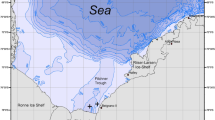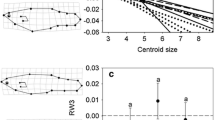Abstract
Two populations of Cyanea, one in the Niantic River estuary and the other in the adjacent Niantic Bay portion of Long Island Sound, were studied for more than a decade. The estuary and the bay are connected by a narrow channel: this and hydrographic features constrain transport between them. Specimens from each site exhibit morphological and seasonal differences comparable to those which distinguish C. capillata from C. lamarckii in European waters. Reproducing River medusae never cooccurred with reproducing Bay medusae. Estuarine jellyfish are sometimes found in the Bay, but reproducing individuals have not been seen there. Reproductively mature Bay jellyfish occasionally appear in the River, but benthic samples show that they do not deposit planulae at this site and thus do not contribute to the next generation of medusae in the River. Such differences suggest an absence of gene flow between these two populations, indicating that the River medusae and Bay medusae might be separate species.
Similar content being viewed by others
References
Agassiz, L., 1862. Contributions to the natural history of the United States of America, 4. Little, Brown & Company, Boston, 380 pp.
Bigelow, H. B., 1913. Medusae and Siphonophorae collected by the United States fisheries steamer ‘Albatross’ in the northwestern Pacific, 1906. Proc. U. S. natn. Mus. 44: 1–119.
Brewer, R. H., 1989. The annual pattern of feeding, growth, and sexual reproduction in Cyanea (Cnidaria: Scyphozoa) in the Niantic River Estuary, Connecticut. Biol. Bull. 176: 272–281.
Gröndahl, F., 1988. A comparative ecological study on the scyphozoans Aurelia aurita, Cyanea capillata and C. lamarckii in the Gullmar Fjord, western Sweden, 1982–1986. Mar. Biol. 97: 541–550.
Kramp, P. L., 1937. Polypdyr (Coelenterata). II. Gopler. Damn. Fauna 43: 1–223.
Kramp, P. L., 1961. Synopsis of the medusae of the world. J. mar. biol. Ass. U.K. 40: 1–469.
Long, K. O. & J. W. Burnett, 1989. Isolation, characterization, and comparison of hemolytic peptides in nematocyst venoms of two species of jellyfish (Chrysaora quinquecirrha and Cyanea capillata). Comp. Biochem. Physiol. 94B: 641–646.
Mackie, G. O., 1974. Locomotion, flotation, and dispersal. In L. Muscatine & H. M. Lenhoff (eds), Coelenterate biology: Reviews and New Perspectives. Academic Press, N.Y.: 313–357.
Marshall, N., 1960. Studies of the Niantic River, Connecticut with special reference to the bay scallop, Aequipecten irradians. Limnol. Oceanogr. 5: 86–105.
Marshall, N. & S. D. Hicks, 1962. Drift of medusae and their distribution in relation to the hydrography of the Niantic River, Connecticut. Limnol. Oceanogr. 7: 268–269.
Marshall, N. & B. M. Wheeler, 1965. Role of the coastal and upper estuarine waters contributing phytoplankton to the shoals of the Niantic estuary. Ecology 46: 665–673.
Mayer, A. G., 1910. Medusae of the world. Volume III. The Scyphomedusae. Publs Carnegie Instn 109: 499–735.
Rice, N. E. & W. A. Powell, 1972. Observations on three species of jellyfishes from Chesapeake Bay with special reference to their toxins. II. Cyanea capillata. Biol. Bull. 143: 617–622.
Russell, F. S., 1970. The medusae of the British Isles. II. Pelagic Scyphozoa with a supplement to the first volume on hydromedusae. Cambridge University Press, Cambridge, 281 pp.
Saila, S. B., 1976. Effects of power plant entrainment of winter flounder populations near Millstone Point, Connecticut. Rep. Univ. Rhode Island-Northeast Utilities Service Co. 5: 1–139.
Sissenwine, M. B., K. W. Hess & S. B. Saila,1973. A mathematical model for evaluating the effect of power plant entrainment of populations near Millstone Point, Connecticut. Marine Experimental Station Rep. Univ. Rhode Island-Northeast Utilities Service Co. 1: 1–77.
Stiasny, G., 1930. Die Scyphomedusen-Sammlung des ‘Musée Royal d'Histoire Naturelle de Belgique’ in Brüssel. Mém. Mus. Hist. nat. Belg. 42: 1–32.
Stiasny, G. & H. van der Maaden, 1943. Über Scyphomedusen aus dem Ochotskischen und Kamtschatka Meer nebst einer Kritik der Genera Cyanea and Desmonema. Zool. Jb., Abt. Syst. 76: 227–266.
Thiel, M. E., 1962a. Untersuchungen zur Artfrage von Cyanea lamarckii Pér. et Les. and Cyanea capillata L. Abh. Verh. naturw. Ver. Hamburg (NF)(1961) 6: 277–293.
Thiel, M. E., 1962b. Scyphomedusae. 4. Semaeostomae. Ökologie, Geschichte ihrer Kenntnis, ihre Stammesgeschichte and Klassifikation. Bronn's Kl. Ordn. Tierreichs 2: 1073–1308.
Van der Maaden, H., 1942. Über Cyanea capillata Eschscholtz und die sog. var. lamarcki Péron & Lesueur. Zool. Anz. 137: 63–70.
Author information
Authors and Affiliations
Rights and permissions
About this article
Cite this article
Brewer, R.H. Morphological differences between, and reproductive isolation of, two populations of the jellyfish Cyanea in Long Island Sound, USA. Hydrobiologia 216, 471–477 (1991). https://doi.org/10.1007/BF00026501
Issue Date:
DOI: https://doi.org/10.1007/BF00026501




